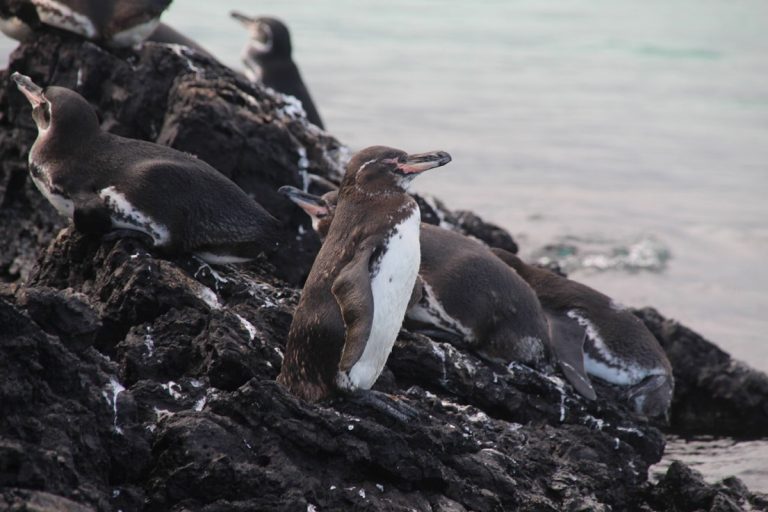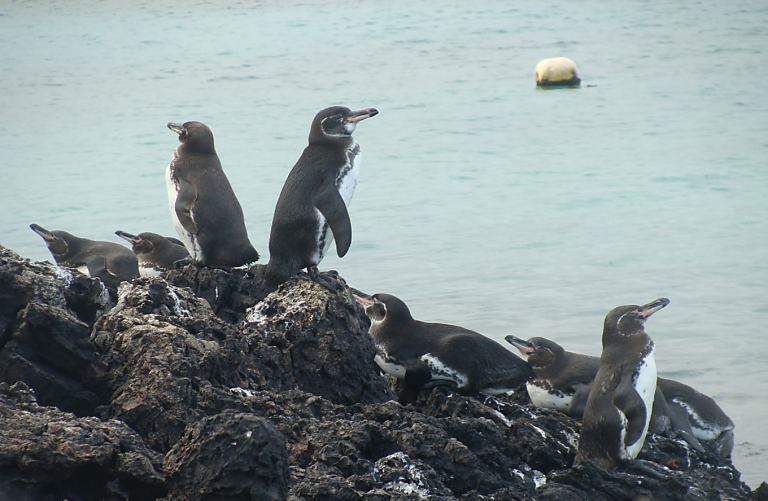
A Galápagos penguin is perched on the molten rock of the Isabela Islands. The authors captured this photo during a 2021 expedition to collect microplastics in the Galápagos Marine Reserve. Image Credit: Karly McMullen, CC-BY 4.0
An analysis of seawater collected around Santa Cruz Island, a human-populated island, with nearby Galápagos penguin colonies revealed plastic particles. Using models that focused on the Galápagos penguin diet (barracuda, sardine, herring, salema, and anchovy), and on penguin scat, researchers intuited a unique Galápagos penguin food web model using Ecopath and Ecosim (EwE) ecosystem modeling with the Ecotracer approach to track the bioaccumulation potential of microplastics in the penguins’ foodweb. They also applied a wider model for Bolivar Channel Ecosystem (between Fernandina and Isabela islands) and part of the penguin’s habitats, located at the western regions of the Galápagos Islands.
The model predictions showed a rapid increase in microplastic accumulation and contamination across the penguins’ prey organisms resulting in Galápagos penguin displaying the highest level of microplastics per biomass, followed by barracuda, anchovy, sardine, herring, salema, and predatory zooplankton.

A gang of Galápagos penguin (Spheniscus mendiculus) resting on lava rock and vigilant in front of the ocean observed in October 2021 at Isabela Island, Galápagos Islands (Ecuador). Note, the floating plastic buoy (made of either expanded polystyrene (known as Styrofoam), or polyurethane) at the background. Photo credit: Dr. Juan José Alava (Ocean Pollution Research Unit, IOF)
“The model predictions highlight the accumulation behavior and residence time of microplastics in the gut,” said Karly McMullen, first author and recent MSc graduate from the Institute for the Oceans and Fisheries at the University of British Columbia. “With microplastics emerging as a prominent ocean pollutant, entering the environment every day, there is a growing concern for marine fauna and coastal wildlife, particularly if this anthropogenic threat is reaching even the most remote and protected areas such as the Galápagos Archipelago.”
Senior author, honorary research associate and Principal Investigator of the Ocean Pollution Research Unit at Institute for the Oceans and Fisheries at the University of British Columbia, Dr. Juan Jose Alava, agreed. “The goal of this food web bioaccumulation modeling work was to provide science and data to support risk management of hazardous plastic waste, reduce microplastic emissions in the oceans and marine remote UNESCO Heritage sites such as the Galápagos Islands, and inform local and international marine policy to conserve endangered, endemic seabird species of Galápagos Marine Reserve.”
“It is imperative that we prioritizing efforts to reduce the input of microplastics into vulnerable ecosystems and food webs, particularly such as that of the endangered Galápagos penguin.”
Modelling microplastic bioaccumulation and biomagnification potential in the Galápagos penguin ecosystem using Ecopath and Ecosim (EwE) with Ecotracer, was published in PLOS ONE.
Tags: Ecuador, Galápagos, IOF alumni, IOF Research Associates, IOF students, Juan Jose Alava, microplastics, OPRU, penguins, plastic, pollution, Research